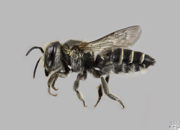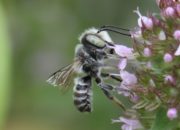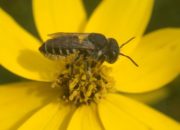This small Leafcutter Bee was introduced to the US for pollination of alfafa. It is widely distributed in Vermont and can be found in many urban and semi-disturbed environments. Bird's-foot Trefoil (Lotus corniculatus) and other similar legumes are good places to look.
Unless otherwise specified, specimen photos in the grid are courtesy of Margarita Miklasevskaja at PCYU with funding from NSERC-CANPOLIN.
In some parts of the continent, this species is actively managed for pollination services. They readily accept bee hotels and can easily be moved. A non-native cleptoparasite of Alfalfa Leafcutter Bees – the Red-tipped Cuckoo Leaf-cutter Bee (Coelioxys coturnix) – has recently shown up in the eastern US and could find its way to Vermont.
Identification: Females of this species (along with the Apical Leafcutter Bee – below) can be recognized by the presence of bands of short white hair on the underside of the abdomen. Males can be quite small and appear large headed, though are similar to several other Leafcutter bees.
Similar Species: Another non-native species, the Apical Leafcutter Bee (Megachile apicalis), is quite similar to the Alfala Leafcutter Bee. So far it has not been found in Vermont, but occurs as close as Albany, NY and is likely to spread further. It appears to have a distinct preference for Knapweeds (Genus Centaurea).
Global Status: Secure
Vermont Status: Introduced
For more information, visit the following links:
Discover Life
Living Atlas Species Page
Distribution:
To see the global distribution, check out the iNaturalist account, and toggle the GBIF layer on the map.









